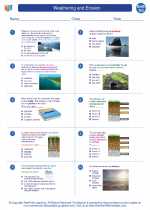Seasons
Seasons are the result of the Earth's axial tilt and its orbit around the Sun. The Earth's axis is tilted at an angle of about 23.5 degrees relative to the plane of its orbit around the Sun. This tilt causes different parts of the Earth to receive varying amounts of sunlight throughout the year, leading to the four distinct seasons: spring, summer, fall, and winter.
Causes of Seasons
The changing seasons are primarily caused by the tilt of the Earth's axis and its orbit around the Sun. During different times of the year, different parts of the Earth are tilted towards or away from the Sun, resulting in variations in the intensity and duration of sunlight received.
Effects of Seasons
The changing seasons impact various aspects of the Earth, including temperature, weather patterns, vegetation, and animal behavior. For example, summer is typically characterized by warmer temperatures and longer days, while winter is associated with colder temperatures and shorter days.
Study Guide
Here are key points to remember when studying seasons:
- Understand the reason for the Earth's seasons, which is the tilt of its axis and its orbit around the Sun.
- Learn the characteristics of each season, including temperature, daylight hours, and typical weather patterns.
- Be familiar with the impact of seasons on ecosystems and human activities, such as agriculture and outdoor recreation.
- Review the solstices and equinoxes, which mark the beginning of each season.
- Practice identifying the position of the Earth relative to the Sun during each season and how it influences sunlight distribution.
◂Earth Science Worksheets and Study Guides High School. Weathering and Erosion

 Worksheet/Answer key
Worksheet/Answer key
 Worksheet/Answer key
Worksheet/Answer key
 Vocabulary/Answer key
Vocabulary/Answer key
 Vocabulary/Answer key
Vocabulary/Answer key
 Vocabulary/Answer key
Vocabulary/Answer key
